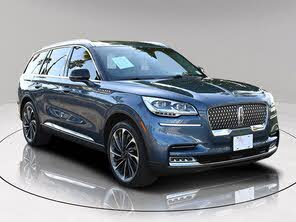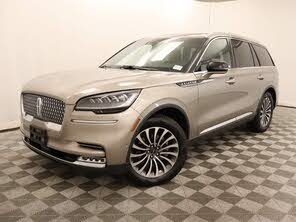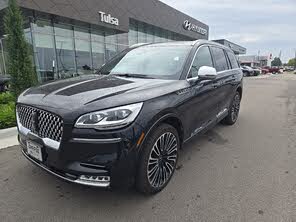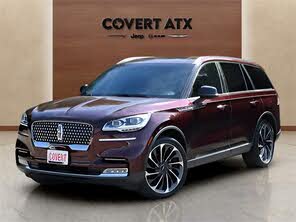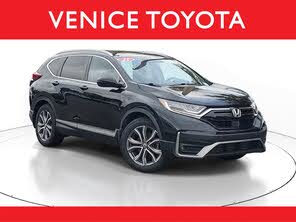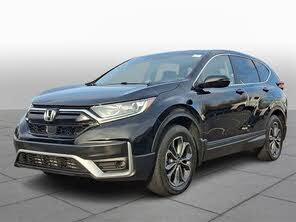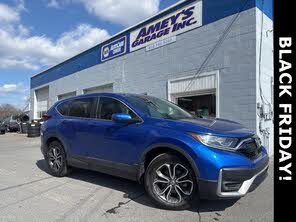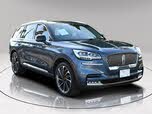2020 Lincoln Aviator vs 2021 Honda CR-V
Overview | |
MSRP$51,100 | MSRP$25,350 |
Listings591 | Listings1266 |
Ratings & Reviews | |
User Reviews | User Reviews |
Expert reviews8.2 out of 10 | Expert reviews7.8 out of 10 |
Pros
Cons
| Pros
Cons
|
2020 Lincoln Aviator Reviews SummaryThe heyday for Lincoln was more than a half-century ago. Those postwar years of prosperity and optimism were the perfect time for cars like the Continental and others. They delivered comfort and luxury, wrapped in midcentury modern styling. Even as recently as the 1990s, Lincoln was still a popular brand, riding the SUV craze with its Navigator. But after the turn of the century, Lincoln lost its ability to create new designs and looked inward and backward. Sure, retro-themed cars like the redesigned Mustang, PT Cruiser, and Chevy HHR had turned some heads, but none of those came from luxury brands. The BMWs and Mercedes of the world were all looking forward and pushing the envelope for contemporary automotive design. Meanwhile, Lincoln offered the MKX, which was based on the Ford Edge and featured ’66 Continental styling. Neat in a vacuum, but off-base compared to the modern luxury market. This experimental phase with various retro looks coincided with the move to the MK-# alphabet-soup naming convention and big improvements in the Ford lineup, where top-end trims of the Fusion overlapped with an entry-level trim of the MKZ. The combination left Lincoln a confusing, anonymous afterthought in the modern luxury game. But Lincoln is finally ready to change all that. It has a new cohesive design language, its focus is once again on luxury, and the three-letter naming convention that never meant anything to anyone other than Lincoln marketers is gone. The brand led with the 2017 Continental and 2018 Navigator, which are each impressive in their own right. But the company's lineup is growing and now includes the all-new 2020 Lincoln Aviator. Named after a luxury variant of the 2002-2005 Ford Explorer, this new Aviator is also based on the contemporary Explorer platform, but it's a luxury vehicle in its own right. Much of the success of the Lincoln brand may hinge on this midsize, 3-row luxury SUV, so you need to consider its competition, such as the Audi Q7, Infiniti QX60, and all-new Cadillac XT6. Read on to learn if Lincoln’s take on luxury will stand out in a crowded competitive field. | |
2021 Honda CR-V Reviews SummaryEven in a grim year, Honda is selling a staggering number of CR-Vs. The CR-V is the best-selling Honda by far. It’s also the second best-selling compact SUV, just behind the Toyota RAV4. And it's the fifth best-selling vehicle in the U.S., and if you take out all the commercial sales of full-size pickups it’s one of the two best-selling vehicles year in and year out. So it’s hard to argue against the CR-V formula. Honda’s been at this almost as long as crossovers have been a thing, launching the CR-V in 1997—a year after the RAV4 debuted. The funny thing is, aside from sales volume, there’s only one thing the CR-V particularly excels at. Aesthetics are subjective, but it would be hard to argue the CR-V is the best looking vehicle in its class. It’s not the cheapest. It’s not the best equipped, especially at the middle to lower trim levels. It’s not the fastest, nor is it the quietest, or the most fuel efficient. It’s not even the most reliable, showing up nowhere in J.D. Power's Most Reliable list. So what makes it so appealing to American consumers? Let’s see if we can figure that out. | |
No video found | |
Popular Features & Specs | |
Engine3.0L 400 hp V6 | Engine1.5L 190 hp I4 |
Drive TrainRWD | Drive TrainFWD |
Seating Capacity7 | Seating Capacity5 |
Horsepower | Horsepower190 hp @ 5600 rpm |
MPG City18 | MPG City28 |
MPG Highway26 | MPG Highway34 |
Engine | |
Engine Name3.0L 400 hp V6 | Engine Name1.5L 190 hp I4 |
Torque | Torque179 lb-ft @ 2000 rpm |
Horsepower | Horsepower190 hp @ 5600 rpm |
DrivetrainRWD | DrivetrainFWD |
Fuel Economy | |
MPG City18 | MPG City28 |
MPG Highway26 | MPG Highway34 |
Interior | |
Seating Capacity7 | Seating Capacity5 |
Safety | |
Front Crash Overall5 | Front Crash Overall5 |
Side Crash Overall5 | Side Crash Overall5 |
Dimensions & Capacity | |
Cargo Space18.3 cu ft | Cargo Space39.2 cu ft |
Curb Weight4764 lbs | Curb Weight3337 lbs |
Height69.8 in | Height66.1 in |
Length199.3 in | Length182.1 in |
Width89.9 in | Width73.0 in |
Wheelbase119.1 in | Wheelbase104.8 in |
Maximum Payload | Maximum Payload1358 lbs |
Number of doors4 | Number of doors4 |
Maximum Towing Capacity | Maximum Towing Capacity1500 lbs |
Overview | ||
MSRP | $51,100 | $25,350 |
Listings | ||
Ratings & Reviews | ||
User reviews | ||
Expert reviews | 8.2 out of 10Read full review | 7.8 out of 10Read full review |
Pros & cons | Pros
Cons
| Pros
Cons
|
Summary | The heyday for Lincoln was more than a half-century ago. Those postwar years of prosperity and optimism were the perfect time for cars like the Continental and others. They delivered comfort and luxury, wrapped in midcentury modern styling. Even as recently as the 1990s, Lincoln was still a popular brand, riding the SUV craze with its Navigator. But after the turn of the century, Lincoln lost its ability to create new designs and looked inward and backward. Sure, retro-themed cars like the redesigned Mustang, PT Cruiser, and Chevy HHR had turned some heads, but none of those came from luxury brands. The BMWs and Mercedes of the world were all looking forward and pushing the envelope for contemporary automotive design. Meanwhile, Lincoln offered the MKX, which was based on the Ford Edge and featured ’66 Continental styling. Neat in a vacuum, but off-base compared to the modern luxury market. This experimental phase with various retro looks coincided with the move to the MK-# alphabet-soup naming convention and big improvements in the Ford lineup, where top-end trims of the Fusion overlapped with an entry-level trim of the MKZ. The combination left Lincoln a confusing, anonymous afterthought in the modern luxury game. But Lincoln is finally ready to change all that. It has a new cohesive design language, its focus is once again on luxury, and the three-letter naming convention that never meant anything to anyone other than Lincoln marketers is gone. The brand led with the 2017 Continental and 2018 Navigator, which are each impressive in their own right. But the company's lineup is growing and now includes the all-new 2020 Lincoln Aviator. Named after a luxury variant of the 2002-2005 Ford Explorer, this new Aviator is also based on the contemporary Explorer platform, but it's a luxury vehicle in its own right. Much of the success of the Lincoln brand may hinge on this midsize, 3-row luxury SUV, so you need to consider its competition, such as the Audi Q7, Infiniti QX60, and all-new Cadillac XT6. Read on to learn if Lincoln’s take on luxury will stand out in a crowded competitive field. | Even in a grim year, Honda is selling a staggering number of CR-Vs. The CR-V is the best-selling Honda by far. It’s also the second best-selling compact SUV, just behind the Toyota RAV4. And it's the fifth best-selling vehicle in the U.S., and if you take out all the commercial sales of full-size pickups it’s one of the two best-selling vehicles year in and year out. So it’s hard to argue against the CR-V formula. Honda’s been at this almost as long as crossovers have been a thing, launching the CR-V in 1997—a year after the RAV4 debuted. The funny thing is, aside from sales volume, there’s only one thing the CR-V particularly excels at. Aesthetics are subjective, but it would be hard to argue the CR-V is the best looking vehicle in its class. It’s not the cheapest. It’s not the best equipped, especially at the middle to lower trim levels. It’s not the fastest, nor is it the quietest, or the most fuel efficient. It’s not even the most reliable, showing up nowhere in J.D. Power's Most Reliable list. So what makes it so appealing to American consumers? Let’s see if we can figure that out. |
Video | No video found | |
Popular Features & Specs | ||
Engine | 3.0L 400 hp V6 | 1.5L 190 hp I4 |
Drive Train | RWD | FWD |
Seating Capacity | 7 | 5 |
Horsepower | 190 hp @ 5600 rpm | |
MPG City | 18 | 28 |
MPG Highway | 26 | 34 |
Engine | ||
Engine Name | 3.0L 400 hp V6 | 1.5L 190 hp I4 |
Torque | 179 lb-ft @ 2000 rpm | |
Horsepower | 190 hp @ 5600 rpm | |
Drivetrain | RWD | FWD |
Fuel Economy | ||
MPG City | 18 | 28 |
MPG Highway | 26 | 34 |
Interior | ||
Seating Capacity | 7 | 5 |
Safety | ||
Front Crash Overall | 5 | 5 |
Side Crash Overall | 5 | 5 |
Dimensions & Capacity | ||
Cargo Space | 18.3 cu ft | 39.2 cu ft |
Curb Weight | 4764 lbs | 3337 lbs |
Height | 69.8 in | 66.1 in |
Length | 199.3 in | 182.1 in |
Width | 89.9 in | 73.0 in |
Wheelbase | 119.1 in | 104.8 in |
Maximum Payload | 1358 lbs | |
Number of doors | 4 | 4 |
Maximum Towing Capacity | 1500 lbs | |
The 2020 Lincoln Aviator was positioned between the Navigator and the compact MKC (later replaced by the Lincoln Corsair) in Lincoln's lineup. It marked a return to real vehicle names, moving away from the old alphabet-soup naming convention. The Aviator featured a unified design language across Lincoln's sedans, crossovers, and SUVs, with handsome headlights and an upright chrome grille. Its tapering roofline and low, wide beltline gave it an elongated, almost boat-like appearance.
Inside, the Aviator boasted a flowing design with soft-touch materials and selective use of brightwork. The seats were both elegant and sturdy, with shifter buttons designed like piano keys. The front seats were incredibly comfortable, using plush leather throughout the cabin, even in areas where it wasn't necessary. The Aviator also featured a massive panoramic moonroof and unique warning jingles recorded by the Detroit Symphony Orchestra, showcasing Lincoln's commitment to a holistic luxury experience. The lineup included five trims, with the Standard trim offering a well-equipped base model and the Black Label Grand Touring trim featuring a plug-in hybrid drivetrain.
The 2021 Honda CR-V, on the other hand, had a design that blended in with other compact crossovers. Its styling was nearly identical to its competitors, with only a few details like the grille opening and some chromed plastic features setting it apart. The CR-V was available in eight colors, but most were shades of gray, black, or white, with only a few vibrant options limited to higher trims. The interior offered black, gray, and ivory cloth or leather, with wood panels and more chrome available on higher trims. The seats had a modern, angular design, but the overall styling was less distinctive compared to competitors like the Kia Sportage and Hyundai Tucson.










The 2020 Lincoln Aviator came standard with a twin-turbocharged 3.0-liter V6 engine, producing 400 horsepower and 415 pound-feet of torque. The Grand Touring trim combined this engine with a 100-hp electric motor, resulting in a net 494 hp and 630 lb-ft of torque. Both powertrains used a 10-speed automatic transmission, with the base V6 offering rear-wheel drive (RWD) or all-wheel drive (AWD), while the plug-in hybrid (PHEV) was AWD only. Both versions could accelerate from 0-60 mph in about 4 seconds. The PHEV provided a smooth driving experience with its electric power at low speeds, and the Aviator's steering and brakes offered a refined, cushioned feel. Fuel economy for the RWD Aviator was 18 mpg city, 26 highway, 21 combined, while the AWD version achieved 17, 24, 20. The PHEV had a combined 23 mpg, with a 21-mile electric-only range and a 56 miles-per-gallon equivalent combined rating.
The 2021 Honda CR-V featured a 190-horsepower turbocharged four-cylinder engine across all nine trims (excluding the CR-V Hybrid). It accelerated from 0-60 mph in about 7.8 seconds, which was competitive within its class. The CR-V used a continuously variable transmission (CVT), which provided smooth but less engaging acceleration compared to competitors with conventional automatic transmissions. The CR-V came standard with front-wheel drive (FWD), with AWD available as an option. Its suspension setup included a MacPherson strut front and multi-link rear, offering decent handling and ride quality. The CR-V's performance was adequate for everyday driving, but it lacked the excitement of some rivals.
The 2020 Lincoln Aviator, with its three-row seating, competed with vehicles like the Audi Q7, Infiniti QX60, and Mercedes-Benz GLE. The optional second-row captain's chairs were fantastic, while the power-closing third row was best suited for kids on longer trips. With the second and third rows folded, the Aviator offered 77 cubic feet of cargo space, comparable to the Cadillac XT6. However, the Aviator's controls, including the seats and door handles, were overly complicated. The 30-way seats had a massage function, but their controls were split between a door-mounted panel and the center touchscreen. The door-release function was also confusing, with a button instead of a conventional handle, raising concerns about usability in emergencies.
The 2021 Honda CR-V prioritized function, aiming to fit five people comfortably and carry their gear. It offered 102.9 cubic feet of passenger volume, more than the Toyota RAV4, and 75.8 cubic feet of cargo space with the rear seats folded. The tailgate options varied by trim, with the base models requiring manual operation, while higher trims offered power and hands-free tailgate options. Roof rails were standard only on the top Touring trim, limiting roof storage options for lower trims. Overall, the CR-V provided ample space and practicality for everyday use.
The 2020 Lincoln Aviator featured the Sync 3 infotainment system with a 10.1-inch touchscreen, offering a user-friendly interface with Apple CarPlay and Android Auto integration. The fully digital instrument panel and head-up display provided clear and concise information. The Aviator's tech setup was well-executed, with a landscape layout for the touchscreen that made it easy to use.
The 2021 Honda CR-V's base LX trim had a basic 5-inch color screen with Bluetooth connectivity. Higher trims featured a 7-inch high-definition touchscreen with Apple CarPlay and Android Auto integration. The audio system varied by trim, with the Touring trim offering a 300-watt system with a subwoofer. Charging ports were plentiful in all but the base trim, with USB ports in the front and second rows. The Touring trim also included a wireless phone charger. The CR-V's tech offerings were adequate, but not as advanced as the Aviator's.
The 2020 Lincoln Aviator came standard with a full array of front and side-impact airbags, traction control, and a tire pressure monitoring system. The Lincoln Co-Pilot360 suite included forward-collision avoidance, lane-departure warning, adaptive cruise control, automatic high beams, blind-spot monitoring, and a head-up display.
The 2021 Honda CR-V excelled in safety, earning a five-star NHTSA overall crash test rating and an IIHS Top Safety Pick award. However, it missed the Top Safety Pick+ rating due to lower scores in headlight evaluation and the updated side crash test. The CR-V's Honda Sensing system included forward collision warning, lane departure warning, automatic emergency braking, road departure mitigation, lane keeping assist, adaptive cruise control, and auto high-beam headlamps. Blind spot monitoring with rear cross-traffic alert was standard from the EX trim upwards.
CarGurus highlights
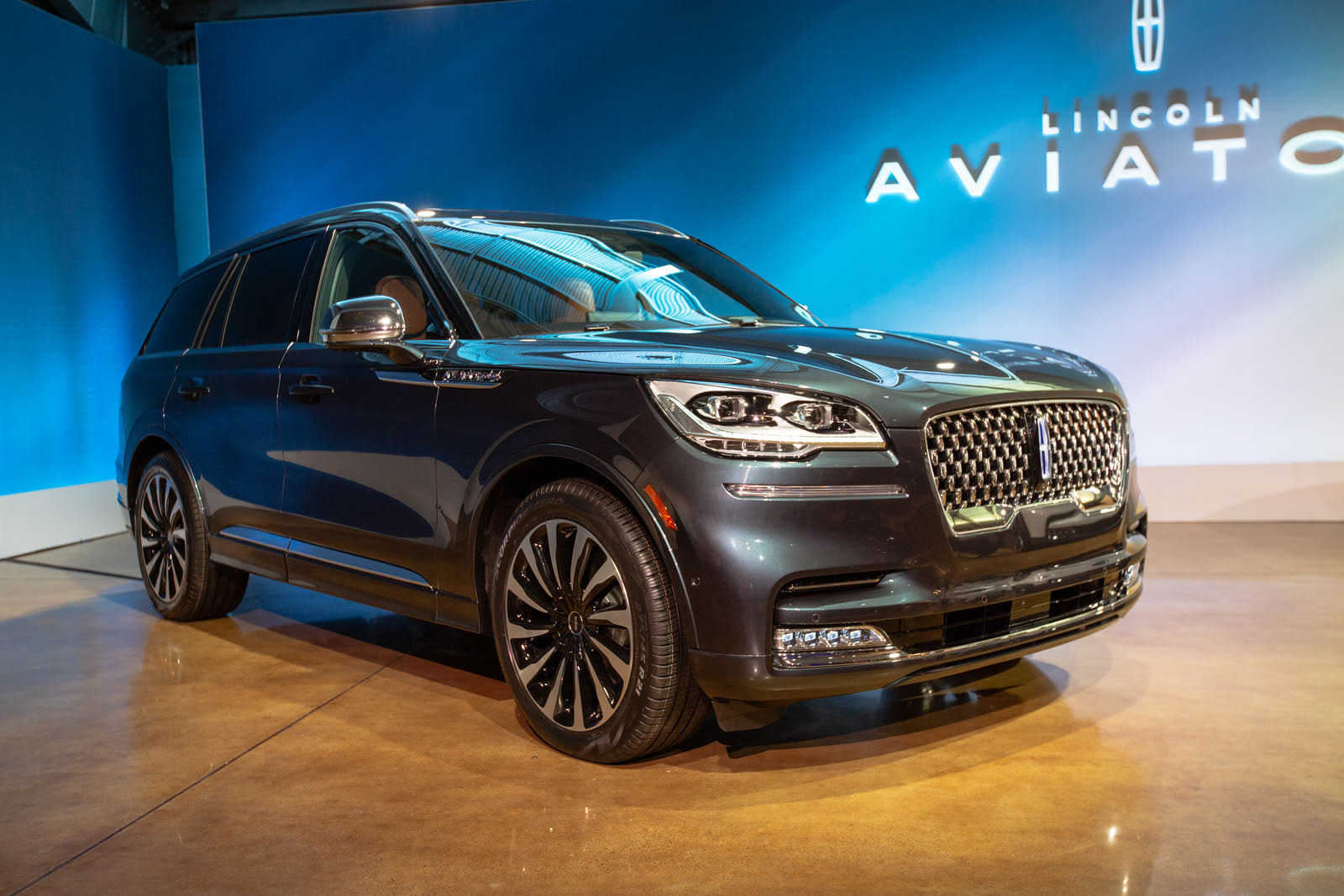
According to CarGurus experts, the overall rating for the 2020 Lincoln Aviator is 8.2 out of 10, while the 2021 Honda CR-V scores 7.8 out of 10. Based on these ratings, the 2020 Lincoln Aviator is the recommended choice for its superior luxury, performance, and technology.
Choose the 2020 Lincoln Aviator if:
- You prioritize a luxurious interior with high-quality materials and unique features.
- You want a powerful engine with impressive acceleration and a smooth driving experience.
- You need a three-row SUV with ample cargo space and advanced technology.
Choose the 2021 Honda CR-V if:
- You value safety and want a vehicle with top safety ratings and comprehensive standard safety features.
- You need a practical and spacious vehicle for carrying passengers and cargo.
- You prefer a more affordable and fuel-efficient compact crossover.
CarGurus highlights

According to CarGurus experts, the overall rating for the 2020 Lincoln Aviator is 8.2 out of 10, while the 2021 Honda CR-V scores 7.8 out of 10. Based on these ratings, the 2020 Lincoln Aviator is the recommended choice for its superior luxury, performance, and technology.
Choose the 2020 Lincoln Aviator if:
Shop Now- You prioritize a luxurious interior with high-quality materials and unique features.
- You want a powerful engine with impressive acceleration and a smooth driving experience.
- You need a three-row SUV with ample cargo space and advanced technology.
Choose the 2021 Honda CR-V if:
Shop Now- You value safety and want a vehicle with top safety ratings and comprehensive standard safety features.
- You need a practical and spacious vehicle for carrying passengers and cargo.
- You prefer a more affordable and fuel-efficient compact crossover.

By: CarGurus + AI
At CarGurus, our team of experienced automotive writers remain at the heart of our content operation, conducting hands-on car tests and writing insightful guides that are backed by years of industry experience. To complement this, we are harnessing AI to make our content offering more diverse and more helpful to shoppers than ever. To achieve this, our AI systems are based exclusively on CarGurus content, ratings and data, so that what we produce is both unique to CarGurus, and uniquely helpful to car shoppers.

